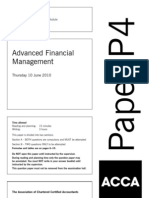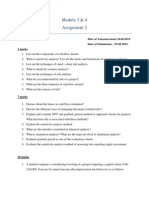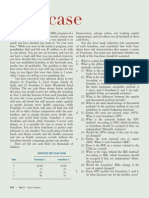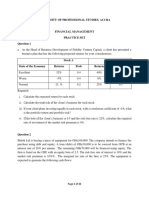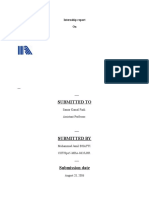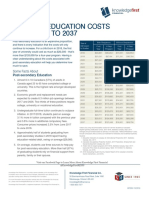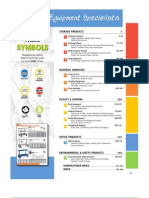Case CF
Case CF
Uploaded by
Taha ShahbazCopyright:
Available Formats
Case CF
Case CF
Uploaded by
Taha ShahbazCopyright
Available Formats
Share this document
Did you find this document useful?
Is this content inappropriate?
Copyright:
Available Formats
Case CF
Case CF
Uploaded by
Taha ShahbazCopyright:
Available Formats
Term project of Corporate Finance
Organo-Foods is a medium-sized organic food producer. It is a quoted stock market company. The Company has brought a range of traditional foods to retailers since it was first set up over 10 years ago. However, growth in the main organic food market is relatively slow compared to segments of the organic juice market. Organo-Foods wants to take advantage of these growth areas. It has commissioned a feasibility study to look into demographic projections for the next 10 years and likely trends in leisure activities. The company is proposing to launch a range of exotic organic juices, like beetroot juice. The company is setting up a separate division to handle this project. New equipment is needed for this project, and will cost 6.3 million. Additional working capital for the project of 1.2 million will be needed. Fixed costs associated with the project amount to 3.15 million per annum. Once operational, it has been forecasted that the division will be able to achieve sales of 900000 cases of organic juice per annum at a price to retailers of 18 per case. It has been estimated that the variable costs associated with the project will be at a level of 65% of sales. The equipment purchased will have an expected life of 7 years, and will be depreciated to zero net book value by that time on a straight line basis. At the end of the 3rd and 5th years the equipment will need servicing; this costs 120000 and is done during the Christmas holidays so no output is lost. The project is expected to end at the end of 7 years, and the equipment is expected to be sold for 450000. The tax rate is 30%, the firm has a seven year 7% coupon bond outstanding, which has a price in the market of 103.25, and the firm has 30% debt in its capital structure. The equity has a beta of 1.4, the risk free rate of interest is 5% and the market risk premium is 6.25%. Required: A. Layout the cash flow schedule for this project, calculate the cost of capital and then calculate the NPV and IRR of the project. B. You have been appointed as a consultant to the project and a number of items have been brought to your attention by the manager in charge of the project. He is comfortable with accounting figures and payback as a technique, but not with discounted cash flow. How should these items be dealt with in the cash flow capital appraisal? What difference do you think they would make to the project? State clearly your reasoning in each case. i. The feasibility study, costing 50000. ii. A loan has been taken out to finance the project, how do we deal with the interest payments? iii. The buildings to be used are owned by the parent company, are currently unused, and are worth 3 million on the open market. iv. There is an increase in debtors due to the project being undertaken. C. In going over the figures, you notice that no mention has been made of inflation. You raise this point and the manager says that inflation is currently under 1% in the economy, and they are happy ignoring it. But from your analysis there is a local labour shortage, which you predict will result in labour costs rising by 3% per annum over the project life. Also the commodity cycle has turned against the company and raw materials are forecasted to rise at 5% per annum for the company. Because of the competitive nature of the sector, sales prices will only rise by the general rate of inflation. Inflation poses a problem in cash flow analysis. In general, how is it dealt with, and in this exam describe how would you conduct the analysis to deal with inflation?
On top of the above requirements you are required to make a financial model of the above case in Microsoft Excel. Submission date: 17th May, 2012 .till 5:00pm!!! Best of Luck!!!!
You might also like
- ICEL Roman Missal Volume 1a.pdf SafeDocument2,182 pagesICEL Roman Missal Volume 1a.pdf SafeJonathan Peeris100% (1)
- Hola Kola Case Study SolutionsDocument8 pagesHola Kola Case Study SolutionsAnushka0% (2)
- F402 In-Class Exercise - Capital Budgeting September 8, 2020Document3 pagesF402 In-Class Exercise - Capital Budgeting September 8, 2020Harrison Galavan0% (1)
- WaterPlayPart2 Summer 2019Document2 pagesWaterPlayPart2 Summer 2019ChaituNo ratings yet
- F9 RM QuestionsDocument14 pagesF9 RM QuestionsImranRazaBozdar50% (2)
- 05 Exercises On Capital BudgetingDocument4 pages05 Exercises On Capital BudgetingAnshuman AggarwalNo ratings yet
- PRQZ 2Document26 pagesPRQZ 2Hoa Long ĐởmNo ratings yet
- Practice-4Document21 pagesPractice-4Akash KumarNo ratings yet
- Word Problems PDFDocument3 pagesWord Problems PDFYzzabel Denise L. Tolentino100% (1)
- Cre PDFDocument4 pagesCre PDFAnurag SharmaNo ratings yet
- 钢材中英文对照Document48 pages钢材中英文对照He Yun QingNo ratings yet
- Case Study (EF 2-1)Document10 pagesCase Study (EF 2-1)Caleesi LiNo ratings yet
- Theory of Financial Risk and Derivative Pricing - From Statistical Physics To Risk Management (S-B) ™Document6 pagesTheory of Financial Risk and Derivative Pricing - From Statistical Physics To Risk Management (S-B) ™jezNo ratings yet
- Hola Kola Case StudyDocument8 pagesHola Kola Case StudyAbhinandan Singh100% (1)
- Advanced Financial Management: Thursday 10 June 2010Document10 pagesAdvanced Financial Management: Thursday 10 June 2010Waleed MinhasNo ratings yet
- PRQZ 2Document31 pagesPRQZ 2Yashrajsing LuckkanaNo ratings yet
- Engineering Economy Problem1Document11 pagesEngineering Economy Problem1frankRACENo ratings yet
- FINC 302 Assignment 2 2023Document6 pagesFINC 302 Assignment 2 2023SEYRAM ADADEVOHNo ratings yet
- Engineering EconomyDocument4 pagesEngineering EconomyHenley Pasion NivalNo ratings yet
- Evaluation of Capital ProjectsDocument3 pagesEvaluation of Capital ProjectsashibhallauNo ratings yet
- International Finance Assignment Apple CorporationDocument3 pagesInternational Finance Assignment Apple Corporationasim27911No ratings yet
- Booklet For Chapter 8Document7 pagesBooklet For Chapter 8saqib aslamNo ratings yet
- IFM FinalDocument3 pagesIFM FinalRana FaisalNo ratings yet
- Chapter 18 - International Capital BudgetingDocument91 pagesChapter 18 - International Capital BudgetingAhmed El KhateebNo ratings yet
- FIN4103Document22 pagesFIN4103sumaiya shafiqNo ratings yet
- Cffinalb SPR 11Document10 pagesCffinalb SPR 11Arun PrabuNo ratings yet
- Assignment For CB TechniquesDocument2 pagesAssignment For CB TechniquesRahul TirmaleNo ratings yet
- Chapter 08 Questions and ProblemsDocument6 pagesChapter 08 Questions and ProblemshuynhhangocthuNo ratings yet
- Management Advisory ServicesDocument18 pagesManagement Advisory ServicesAldrin Arcilla Simeon0% (1)
- Assignment 2Document4 pagesAssignment 2Jayanth Appi KNo ratings yet
- HW 2Document3 pagesHW 2Love MittalNo ratings yet
- Tutorial 3.1. QuestionsDocument3 pagesTutorial 3.1. Questionsamandanokwazi6No ratings yet
- Tutorial 3 For FM-IDocument5 pagesTutorial 3 For FM-IarishthegreatNo ratings yet
- Project Appraisal QuestionDocument4 pagesProject Appraisal Questionnassarjosephine23No ratings yet
- Bai Tap QTTCDocument4 pagesBai Tap QTTCTran PhuongNo ratings yet
- Financial Management Practice Questions... 2021Document33 pagesFinancial Management Practice Questions... 2021obed nkansahNo ratings yet
- Aynur Efendiyeva - Maliye 1Document7 pagesAynur Efendiyeva - Maliye 1Sheen Carlo AgustinNo ratings yet
- Case Study-Multi-Use Commercial Property (1)Document3 pagesCase Study-Multi-Use Commercial Property (1)Ahmed MousaNo ratings yet
- Financial Management Practice Questions... 2021Document34 pagesFinancial Management Practice Questions... 2021Peter EssienNo ratings yet
- STRATEGIC COSTMan QUIZ 3Document5 pagesSTRATEGIC COSTMan QUIZ 3StephannieArreolaNo ratings yet
- 3 - 0607 - Making Capital Investment Decisions. Risk Analysis, Real OptionsDocument3 pages3 - 0607 - Making Capital Investment Decisions. Risk Analysis, Real OptionsPham Ngoc VanNo ratings yet
- 3-1 Scenario Analysis: Project Risk Analysis-ComprehensiveDocument4 pages3-1 Scenario Analysis: Project Risk Analysis-ComprehensiveMinh NguyenNo ratings yet
- financial planDocument4 pagesfinancial planmohamad.monem606No ratings yet
- Financial Analysis: Break-Even PointDocument4 pagesFinancial Analysis: Break-Even PointabtygagisNo ratings yet
- Unit 22 - Project Feasibility StudiesDocument9 pagesUnit 22 - Project Feasibility StudiesMarlou Felix Suarez CunananNo ratings yet
- FinmnDocument5 pagesFinmnprey kunNo ratings yet
- Practice Test MidtermDocument6 pagesPractice Test Midtermrjhuff41No ratings yet
- capital structure practice problemsDocument3 pagescapital structure practice problemskikoNo ratings yet
- Finance Practice 5Document3 pagesFinance Practice 5Puy NuyNo ratings yet
- Revision Question 2023.11.21Document5 pagesRevision Question 2023.11.21rbaambaNo ratings yet
- 1321612987financial AnalysisDocument15 pages1321612987financial AnalysisMuhammad Arslan UsmanNo ratings yet
- Ôn Thi TCDN Kì I 2023 2024Document3 pagesÔn Thi TCDN Kì I 2023 2024Loan Nguyễn BíchNo ratings yet
- Workshop 3Document1 pageWorkshop 3Alia ShabbirNo ratings yet
- Selected BKM Exercises 1 - v2Document19 pagesSelected BKM Exercises 1 - v2Mattia CampigottoNo ratings yet
- Sem IV (Internal 2010)Document15 pagesSem IV (Internal 2010)anandpatel2991No ratings yet
- d15 Hybrid f9 Q PDFDocument8 pagesd15 Hybrid f9 Q PDFhelenxiaochingNo ratings yet
- Measuring Investment Returns: Questions and ExercisesDocument9 pagesMeasuring Investment Returns: Questions and ExercisesKinNo ratings yet
- CostcoClinic Investment Analysis CaseStudyDocument14 pagesCostcoClinic Investment Analysis CaseStudyRahul MalikNo ratings yet
- Investment Appraisal-Fm AccaDocument11 pagesInvestment Appraisal-Fm AccaCorrinaNo ratings yet
- Bus Fin Case StudyDocument6 pagesBus Fin Case StudyMT RANo ratings yet
- Guide to Japan-Born Inventory and Accounts Receivable Freshness Control for Managers 2017 (English Version)From EverandGuide to Japan-Born Inventory and Accounts Receivable Freshness Control for Managers 2017 (English Version)No ratings yet
- Guide to Japan-born Inventory and Accounts Receivable Freshness Control for Managers 2017From EverandGuide to Japan-born Inventory and Accounts Receivable Freshness Control for Managers 2017No ratings yet
- Guide to Japan-born Inventory and Accounts Receivable Freshness Control for managersFrom EverandGuide to Japan-born Inventory and Accounts Receivable Freshness Control for managersNo ratings yet
- 06 Days Ladakh Package - Snehantani SirDocument3 pages06 Days Ladakh Package - Snehantani SirAnik Das 8040No ratings yet
- Nishat Textile MillsDocument48 pagesNishat Textile MillsZubair Ghaznavi50% (2)
- All Conditionals - ExerciseDocument4 pagesAll Conditionals - ExerciseScarlettSamanthaAragonNo ratings yet
- Isd Cy Team Contact Lists - Saint John To SussexDocument3 pagesIsd Cy Team Contact Lists - Saint John To Sussexapi-313161746No ratings yet
- Shiraz Arts FestivalDocument6 pagesShiraz Arts FestivalAngel ColeNo ratings yet
- Heart AttackDocument2 pagesHeart AttackKinga AndrasNo ratings yet
- Engine Lubrication & Cooling SystemsDocument9 pagesEngine Lubrication & Cooling SystemsЮра ПетренкоNo ratings yet
- MarloweDocument2 pagesMarlowecypr7s6zttNo ratings yet
- Sparc M7-8 Server Specifications ArchitectureDocument8 pagesSparc M7-8 Server Specifications ArchitectureJhonny DavisNo ratings yet
- Guide To Education Costs in Canada To 2037Document1 pageGuide To Education Costs in Canada To 2037Daniel ConnoryNo ratings yet
- SCI 4 1st App With TOSDocument6 pagesSCI 4 1st App With TOSJAHYRAH BARTOLOME100% (1)
- BTEC Level 3 National Engineering Teaching Resource Pack Unit 1Document30 pagesBTEC Level 3 National Engineering Teaching Resource Pack Unit 1princedotty50% (2)
- Alfresco Guide: by IT ServicesDocument15 pagesAlfresco Guide: by IT ServiceskosovianNo ratings yet
- StaphylococcusDocument12 pagesStaphylococcusskNo ratings yet
- She communicates with friendі, upload and updates his profile all the timeDocument4 pagesShe communicates with friendі, upload and updates his profile all the timeita100% (1)
- Chapter 5 CasesDocument21 pagesChapter 5 Casesejusdem generis100% (1)
- 109-8833 CYLINDER GP. - TILT 844 : 844H : 844K : D9R : D9T CAT 110-3269 CYLINDER GP. - LIFTDocument14 pages109-8833 CYLINDER GP. - TILT 844 : 844H : 844K : D9R : D9T CAT 110-3269 CYLINDER GP. - LIFTMuvuma JordanNo ratings yet
- Idioms SlangsDocument6 pagesIdioms SlangsTeacher 1No ratings yet
- Quantum Electrodynamcs: November 8, 2017Document125 pagesQuantum Electrodynamcs: November 8, 2017Cosmin IstrateNo ratings yet
- Gaztambide - Pedagogia SolidariaDocument27 pagesGaztambide - Pedagogia SolidariaJoseph Carroll-MirandaNo ratings yet
- Airplane: "Aeroplane" Redirects Here. For Other Uses, See andDocument6 pagesAirplane: "Aeroplane" Redirects Here. For Other Uses, See andVinubhai ShankarNo ratings yet
- M 1 - Grammar...Document10 pagesM 1 - Grammar...Rania singerNo ratings yet
- Drawings ScrubberDocument6 pagesDrawings ScrubberraghbirNo ratings yet
- Farhah Maulydya: Employment HistoryDocument1 pageFarhah Maulydya: Employment HistoryFarhah MaulydyaNo ratings yet
- PFI Catalog 2011 JUL-DEC MotionDocument848 pagesPFI Catalog 2011 JUL-DEC Motioncraig9257No ratings yet
- Task Order and Milestone DataDocument48 pagesTask Order and Milestone DataSanjay BhartiNo ratings yet
- Aldar EventsDocument65 pagesAldar EventsReyNo ratings yet














